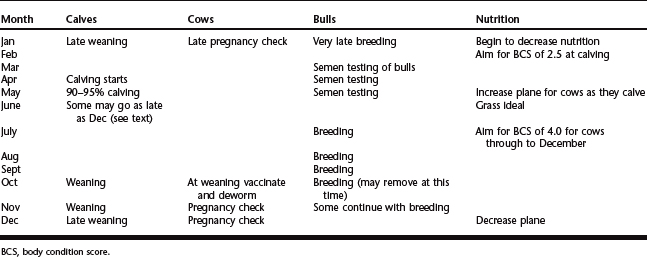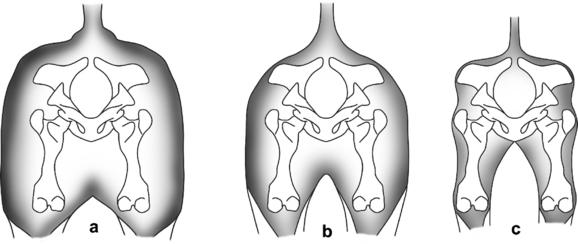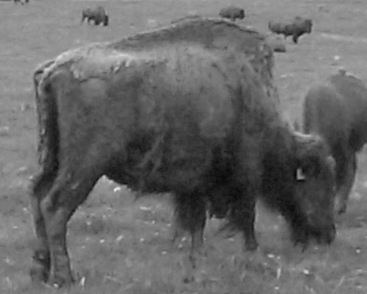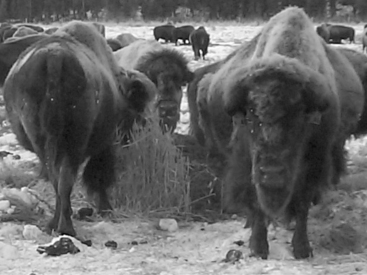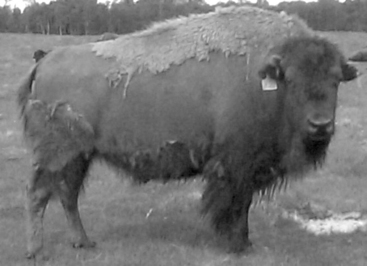CHAPTER 138 Reproductive Management of Bison
REPRODUCTIVE BIOLOGY
Bison in North America are seasonal breeders. Using data collected from several different locales in the Northern Hemisphere, Berger and Cunningham reported that in any given year the earliest calves are seen in the first week of April, and that 25% of births had occurred by April 22. The median birth, over a 5-year period, always fell between May 2 and 8, and 80% of all births had taken place within 55 days of the first one recorded.1 In Northern Alberta the onset of calving often occurs about a week earlier than this. Some later calves may be born in November or even December. A management scheme that describes the events in a bison ranch year is presented in Table 138-1.
Actual mechanisms of control of seasonality have not been studied, and the possibility that the high degree of synchrony is driven by availability of suitable nutrition does exist. Anecdotal evidence from bison ranchers implies that no calvings are seen in the months of January, February, and the first half of March, although such calvings have occasionally been reported.2
On average, bison bulls reached puberty at 16.5 months and should be capable of passing a breeding soundness evaluation by 24 months of age.3
Bison bulls demonstrate a moderate degree of seasonality that is evident in changes of fecal testosterone, testicular histology, and to a limited degree in semen quality.4
Rutley and Rajamahendran,5 in a study of nine plains bison and five wood bison, found that females are seasonally polyestrous and go through a period of about 3 months when there is no evidence of ovarian activity. Using serum and fecal progestin metabolites as indicators of ovarian activity they found that there was a significant difference in concentrations between periods of anestrus and pregnancy, and that open cows entered a period of anestrus in spring. However, they found considerable overlap between fecal progestins of pregnant animals and those not bred, but exhibiting periodic estrus, and even some overlap between nonbred animals and those in anestrus. A similar study involving behavioral observations and the evaluation of fecal progesterone and urinary pregnanediol glucuronide showed that cyclic activity began in early August and ceased in early December.6
PRODUCTIVITY
In some free-ranging herds the productivity is much less than in managed operations. For instance, five parameters of reproductive biology of the free-ranging herds in Yellowstone National Park were examined by Kirkpatrick and associates.7 They found that lactating cows younger than 5 years of age did not conceive, a fact caused by ovulation failure, and that range condition had an effect upon conceptions in cows 4 years old or younger. The pregnancy rates reported for cows of this age would not be acceptable in commercial herds.
However, calving rates for bison in the National Bison Range, Montana, were between 78% and 100%.8 Kirkpatrick and associates7 considered that the three factors of environmental conditions, age, and lactational state influence the overall reproductive performance of the bison in their study, and it is likely that these factors play a role in any mammalian population.
Successful bison managers control parasite loads in their herds either through good pasture management, or the use of anthelmintics at strategic points in the calendar.9 Of particular concern are the stomach worms of the family Ostertaginae, which have been shown to cause death in both winter and spring, mainly through type II ostertagiasis, or in summer by causing debility and reduced productivity, including reproductive failure.10
Good pasture management is essential for the success of breeding programs in bison operations. It is common practice to “flush” bison before the onset of the rut, and ensure that cows enter the breeding season in good body condition.7 At this time most ranched animals are also feeding calves, and on well-managed properties an objective is to achieve as close as possible to a 100% conception rate, even in lactating animals.
Good nutritional management is also essential in the spring months. Dystocia is reported by bison ranchers, and there is little doubt that overfat cows have an increased risk of dystocia, although this has not been critically tested.9
BODY CONDITION SCORING
No formal data have been reported for the use of body condition score (BCS) in bison, and the heavy winter coat can confound accurate field examination. However, a field system of scoring can be used (Table 138-2). Palpation is not an option. Using this system a target BCS of 2.5 (on a scale of 5) can be used for animals entering the breeding season.
Animals in a negative energy situation utilize fat reserves. Subcutaneous fat pads (such as those near the tail-head) disappear first, which leads to clearer muscle definition as the body loses condition. This is especially noticeable on the hindquarters in summer. As interstitial fat is removed muscles appear to subside, dorsal spinous processes seem to protrude more, the neck narrows, and ribs and pelvic structures become more visible. In very thin animals all fat has been metabolized and muscle mass is used as an energy source (see Table 138-2 and Figs. 138-1 to 138-4).
FERTILITY TESTING
Bison bulls are often tested for fertility in May before the breeding season, although many farmers do not test bulls more than once in the bull’s lifetime. Testing is also carried out at other times of year, for instance, before auction sales. Bison bulls can produce semen year-round and examinations of seasonal fluctuation in ejaculate quality have shown that fluctuations do occur, which provides a caveat for those conducting test in late winter or early spring.3 These tests are limited, for the most part, to semen collection by electroejaculation (e-e) followed by its evaluation. Libido testing has not been reported, and it is generally considered too dangerous to carry out scrotal circumference measurements, although these can be done in suitably designed chutes.11 Bison bulls can kick backward with great force and standing directly behind them is not recommended.
In vitro fertilization with either fresh, or frozen-thawed, semen has been used in the production of bison × domestic cattle hybrid embryos and could be employed as a means of testing semen fertility, but is not practical for the bison rancher.12
The only objective report so far published has been the study carried out for 5 consecutive years on a total of 234 bison bulls in the 28- to 30-month-old age group at Custer State Park.11 The 1992 Society for Theriogenology guidelines for beef cattle semen evaluation and reproductive tract examination were used. The authors concluded that scrotal circumference (SC) was significantly correlated with body weight, percentage of normal spermatozoa, percentage of primary spermatozoal defects, and percentage of motile spermatozoa. SC was positively associated with increased odds of semen collection, satisfactory motility, satisfactory morphology, and simultaneous satisfactory motility and morphology. Receiver-operator characteristic curve analysis selected 29 cm as the optimal SC cutoff most predictive of simultaneous satisfactory spermatozoal motility and morphology. The authors further concluded that SC is a good indicator of adequate spermatozoal motility and structure in bison.
The authors also pointed out that the study was limited by the fact that all samples were collected in early October, which is essentially after the end of the breeding season, taking no account for possible seasonal variations. They also pointed out that all the animals came from one location.11
An alternative approach has been employed in a zoo setting, where a small exhibit herd is maintained. The animals are habituated to human presence, and to the chute by keeping it open and allowing them to wander in and out and having the chute associated with the feeding area. This approach generally results in calmer animals when they are handled in the chute for any type of processing.13
Individual motility is detected under higher magnification. The minimum requirement for beef animals is 30%. Some veterinarians use this standard for bison as well. It is possible that this standard should be higher for bison. In an evaluation form designed for one client, the minimum accepted standard for individual motility is 50%.14 However, there are no objective data that confirm or refute this figure. It may be that bulls meeting 30% may be able to breed successfully.
Morphologic criteria are the same for bison bulls as for domestic cattle. The minimum standard accepted for use of a bull in a breeding program is generally taken as 70% normal cells. Nigrosin-eosin is a useful stain, and a Feulgen stain has been used for the examination of nuclear material.3,4
Using Society for Theriogenology beef standards, it has been demonstrated that young bulls do not always pass the first time, as they may not have reached sexual maturity. The commercial bison industry semen tests, and possibly rejects, many developmentally incomplete bulls between 19 and 21 months of age. Studies by Helbig and associates have shown that a failed test at 21 months may be too soon to discard a bull and that those that fail semen tests at this age may be worth testing again at 24 months.3
Table 138-3 shows results of semen evaluation with the following minimum requirements: individual motility of 50%, morphology 70% normal.10,14 No statistical analyses were conducted, but it appears that the percentage of samples rated as satisfactory increases around the age of 2 years.14
Stay updated, free articles. Join our Telegram channel

Full access? Get Clinical Tree


